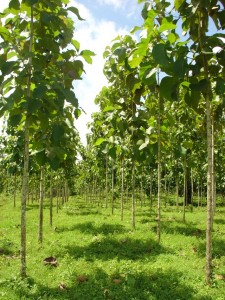
Timber is the most carbon-friendly building material on the planet. Living and working in a timber building means being in a pleasant and healthy green environment. It filters the air and provides a fresh interior climate. It has humidity regulating properties which have positive effects on the atmospheric conditions of a room. On the contrary, concrete is not green-friendly and demands high energy and releases carbon dioxide (CO2) when manufactured, which is one of the primary greenhouse gases that causes climate change. Steel, also not a green-friendly material involves burning fossil fuel byproducts at extremely high temperatures, and is an extremely high energy user and releaser of CO2.
“Every time you see a wood building, it’s a storehouse of carbon from the forest. When you see steel or concrete, you’re seeing the emissions of carbon dioxide that had to go into the atmosphere for those structures to go up.”
 Wood, especially teak and similar tropical hardwoods, on the other hand has a positive CO2 balance and requires less primary energy during the building stage. Wood uses solar energy to grow and stores vast amounts of carbon dioxide during the photosynthesis process. Every cubic meter of wood used as a substitute for other building materials reduces CO2 emissions to the atmosphere by an average of 1.1 tonnes of CO2. If this is added to the 0.9 tonne of CO2 stored in wood, each cubic meter of wood saves a total of 2 tonnes (4,408 lbs.) of CO2.
Wood, especially teak and similar tropical hardwoods, on the other hand has a positive CO2 balance and requires less primary energy during the building stage. Wood uses solar energy to grow and stores vast amounts of carbon dioxide during the photosynthesis process. Every cubic meter of wood used as a substitute for other building materials reduces CO2 emissions to the atmosphere by an average of 1.1 tonnes of CO2. If this is added to the 0.9 tonne of CO2 stored in wood, each cubic meter of wood saves a total of 2 tonnes (4,408 lbs.) of CO2.
And most importantly, wood is sustainable. Teak Bali has initiated a “2 for 1 Reforestation initiative” initiative. To enroll our clients in the sustainability thrust, for all of our clients that purchase a Hardwood Home, Teak Bali provides hardwood seeds to plant on the client’s property. In this way, Teak Bali clients are actually participating in the global sustainability initiative witnessing tangible and genuine re-growth of the hardwoods right in their line of vision. This is a valid way for all of us to contribute back to the planet and is directly related to sustaining the material utilized in construction.
Bruce Lippke, University of Washington professor emeritus of University of Washington School of Environment and Forest Resources.
